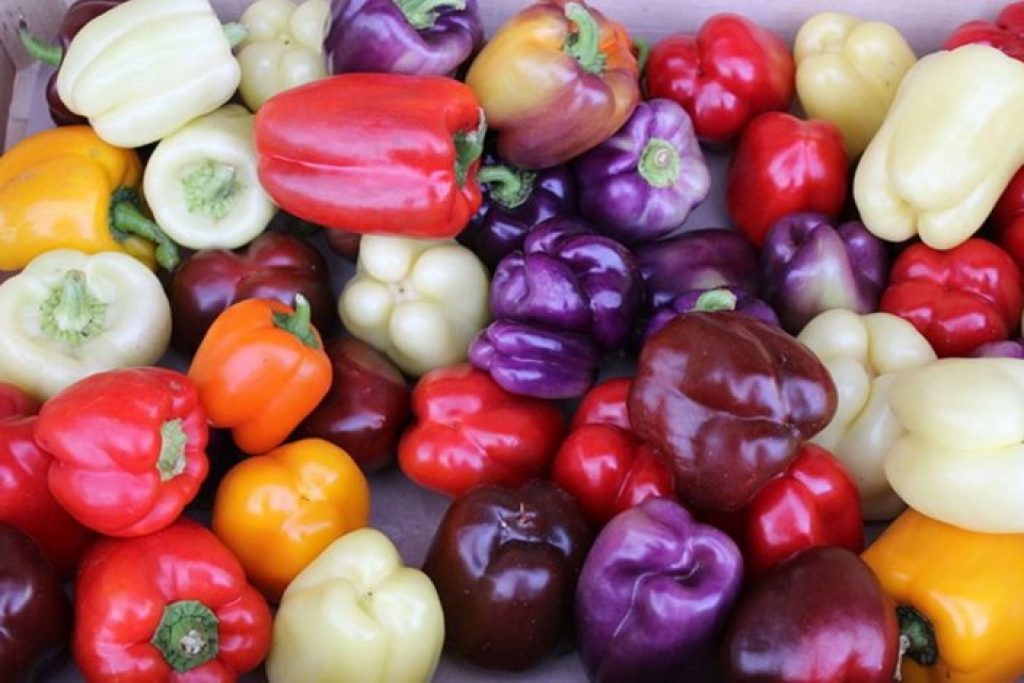If you have cats, you will agree that they may steal that pizza or salad with bell pepper or even stuffed ones. Are bell peppers poisonous or safe for cats, and can cats eat them?
For starters, bell pepper, otherwise known as sweet pepper, capsicum, or just pepper, is a botanical fruit (berry) used in culinary as a vegetable ingredient or served as a side dish. It belongs to the Grossum cultivar group of Capsicum annuum and is the only one that doesn’t produce heat since they have not capsaicin.

Back to your question, the answer is yes. Cats can eat bell peppers in moderation as an occasional treat. Alternatively, you can use a small amount in their homemade diets. All types of sweet pepper, including green, orange, yellow, red, or even rare ones like white, lavender, brown, or dark purple-colored, are safe (not poisonous) to cats.
Capsicums do have some benefits, as we are about to see. However, you should bear three things in mind. First, cats are strict carnivores with no need for fruits or vegetables but may still benefit from them.
Secondly, ensure you know how to properly feed fruits or vegetables to your feline pal to avoid diarrhea, vomiting, or other stomach issues. This is a question of the right amount and correct preparation.
Finally, not all cats will like bell peppers, not even the sweeter ones, as these animals don’t have receptors for sweet taste. Don’t force them if yours don’t happen to love these vegetables if they ignore or recognize them as food.
Are they beneficial?
Looking at their nutritional profile, 100g of raw green peppers have 20 calories, 4.64 g carbohydrates (2.4 sugars and 1.8 dietary fibers), and negligible amounts of protein and fats. They are also rich in vitamin C and have vitamins B6.
Additionally, these capsicums also have manganese, iron, potassium, magnesium, potassium, phosphorus, thiamine, niacin, folate, and the red variety with twice as much vitamin C and eight times vitamin A as the green one.
Some of their benefits include the following:
- They are nutritious – Your feline pal will benefit from the various nutrients they have, which have vital roles in their bodies. For instance, vitamin B6 participates in carbohydrate, amino acid, and fatty acid metabolism, glucose generation, help in niacin synthesis, and may inhibit mammary tumor cell growth, etc.
- Low-calorie snack alternative – With only 20 calories per 100g, they are an excellent low calorie, nutrient-rich alternative to the commercial treats that are high in calories and lower in nutrients.
- Will boost hydration – With 93.9% water, they will help keep your feline pal hydrated, especially, if they are not good drinkers.
- Antioxidant-rich – They have antioxidants like luteolin, quercetin, violaxanthin (in yellow variety), and capsanthin, as well as vitamin C. Antioxidants will neutralize free radicals that damage cells and prevent some chronic illnesses like cancer, heart diseases, and so on.
- Dietary fiber – Fiber will help prevent diarrhea or constipation, promote a healthy gut, help in weight loss, among many benefits. However, fiber isn’t one of the essential dietary needs of felines.
Feeding
Let not the numerous benefits we have mentioned lure you into giving your cat a lot of bell peppers. As strict carnivores, their ability to digest any vegetables or fruits is limited, a reason why you should keep the amounts at minimal and not a meal replacement.
Usually, all treats that your feline eats, including this vegetable, shouldn’t exceed 10% of their total calorie intake. Otherwise, your cats may suffer from nutritional imbalances.
We recommend giving your cats plain steamed, cooked, grilled, or boiled bell peppers without additives (sauce, salt, seasonings, or anything else). Cooking will improve digestibility, i.e., raw ones may be hard to digest and increase indigestion chances. Don’t forget to remove the stalk.
If you prefer raw bell pepper, you can puree and add it to their food. Griding will also help improve digestibility. Remember, their carnivorous teeth don’t grind food as we do.
An issue we have with giving them bite-size raw capsicum is that they may not efficiently digest it. The quick food transit in their digestive system and the low enzyme activity means their ability to digest uncooked plant materials is limited.
As with any other food, slowly introduce sweet peppers starting with a small amount to give their tummies to adjust to the new food as you check how they respond. If it causes diarrhea, nausea, reduced appetite, abdominal discomfort, or vomiting, discontinue it.
If they don’t cause any issues, you can continue increasing the amount over the next one to two weeks but don’t go beyond the treating amount.
Bell pepper plants
If you cultivate them in your garden and your cat has access, there is nothing to worry about if your feline nibbles some leaves as they are safe too. Cats do eat grass and greeneries from time to time due to several reasons.
Conclusion
Sweet peppers are not poisonous to cats, and these pets can eat them as an occasional treat. However, not all will like them and opt for fresh, pureed, or cooked ones to make digestion much more manageable.
However, should your cat overeat sweet peppers or any other non-food material, talk to your vet as it could be a sign of feline pica.
